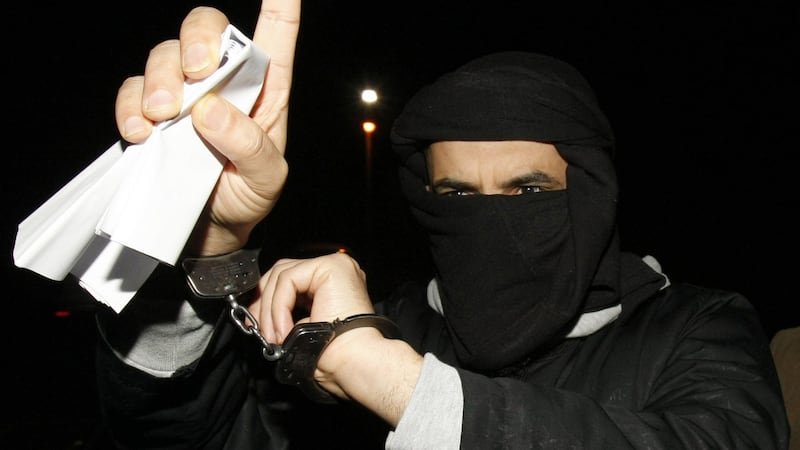Ciaran Cassidy is an award-winning documentarian whose work has featured at Sundance (The Last Days of Peter Bergmann) and the Telluride Film Festival (Collaboration Horizontale). His radio docs have picked up five gold medals at New York Radio Festivals. As we meet, he and journalist Mark Horgan are working on Where Is George Gibney?, a new podcast series on the former swimming coach for BBC Sound. Cassidy has previously covered stories as diverse as an escape from an Irish industrial school and the suicide of a bullied teenage girl. But one project, The Echo Chamber: The Story of Jihad Jane, a radio documentary he produced in 2013, stayed with him.
In 2010, Colleen LaRose, an American woman who called herself "Jihad Jane" on the internet, was charged with trying to recruit Islamic terrorists. She stood accused of taking part in an international conspiracy to kill Lars Vilks, the Swedish cartoonist who ignited a global controversy in 2007 for his depiction of the Prophet Muhammad as a dog. LaRose and another American woman, Jamie Paulin-Ramirez, and an Irish citizen, Algerian-born Ali Charafe Damache, were among a number of people arrested in Waterford in March 2010.

"There was huge fanfare around the story," says Cassidy. "It was a lead story here and it was a lead story all across the States. Katie Couric opened the CBS evening news with it. As a journalist I was kind of curious as to why the story went quiet and what had happened. Eventually Colleen LaRose appeared in court in America and she pleaded guilty. I think she would have got 35 or 50 years otherwise. I just had a lot of questions about what really happened. I was curious about the fact that they were two American women in Waterford. I was curious about the role of the media and the role of the internet.
That's how surreal this story was. Somebody is wandering around Waterford looking for an FBI department
“It’s a story that’s more familiar now, but at the time it felt a lot more of an outlier. Back in 2010 broadband speeds had only started to increase. So people were just starting to put videos up. There was no policing whatsoever on YouTube or the darker corners of the web that everybody is so much more familiar with now.
“So I was just exploring that world. How somebody in Philadelphia and somebody in Colorado and somebody in Baltimore and somebody in Waterford were all planning to kill someone in Sweden. It was all so strange. And it’s a story that couldn’t have happened in the 1960s or 70s it could have only happened at that moment.”
Cassidy's questions form the spine of his fascinating new feature documentary, Jihad Jane. Colleen LaRose's strange radicalisation began following an anonymous sexual encounter with a "Middle Eastern guy" she met on holiday in Amsterdam. Returning to American life, while caring for her elderly mother and her partner's elderly father, she became fascinated by the Arab world and the Palestinian cause. It was a lonely and tough existence for someone her partner Kurt Gorman described as a "social person".
“I was watching videos on YouTube,” LaRose explains. “The thing that had an effect on me was the brutality I was seeing against the Muslims. I would get upset. The blood and the bodies and the children. The day that I was watching the Zionists bombing the Palestinians, you could hear the children screaming and crying and all the women and the brothers. At the same time I was watching this on the internet, outside my window I could hear kids playing and laughing in the streets. And I was thinking to myself, Nobody knows what’s going on.”
“I remember at one of the first production meetings somebody asked: are you going to film in a mosque?” recalls Cassidy. “And I asked: why would I need to film in a mosque? None of the people involved went to a mosque. They never met a preacher. They never met a cleric. They never even talked to a Muslim. This story has nothing to do with religion. This is all about people who were spending eight or nine hours a day on computers.”

LaRose’s obsession eventually brought her to a bedsit above a Chinese restaurant in Waterford, where she encountered another disgruntled American woman, Jamie Paulin Ramirez, and Ali Charaf Damache in order to enforce a fatwa on Lars Vilks. After six frustrating weeks, LaRose went to the authorities to blow the whistle on the entire absurd plot.
“I thought he was like a leader and he had it under control that he had people under him and he could teach me,” LaRose says of Damanche. “It turned out he wasn’t like that at all. He was a liar. He lied to all of us.”
She returned to Philadelphia, only to end up in prison herself.
“I don’t think she saw that it was going to be a big issue,” says Cassidy. “She thought she would go home and go back to Kurt. One of the things that we didn’t put in the film – but if you’re Irish it’s kind of interesting – was she told me that when she was in Waterford and she left the apartment, she went up to the Garda station there looking for the FBI department. So when she walked in the guy behind the desk was really confused about what she wanted, so she headed off and sent the email from the library. That’s how surreal this story was. Somebody is wandering around Waterford looking for an FBI department.”
LaRose, who was released from prison in 2018, is now a Trump supporter living in anonymity. Before her brief, botched career as a self-styled jihadist, she lived a harrowing life. She was raped repeatedly by her biological father from the age of seven before running away in her early teens. She drifted into prostitution, and by 15 she had married one of her johns. A second abusive marriage followed, plus years of substance abuse and a suicide attempt in 2005.
That's not the only affecting story in Jihad Jane. Another co-conspirator, Mohammad Hassan Khalid, who was has Asperger's and was 15 when he became embroiled in the Jihad Jane plot, became the youngest person ever charged with terrorism inside the United States and was sentenced to five years. ("A kid with Asperger's who was getting bullied at school and who went online looking for prayer videos," as Cassidy explains.)
There's a difference if people are writing about murdering someone online and then they're travelling to do it
The film, as with the viewer, is never entirely certain if the great headline-making Jihad Jane plot was anything more than a fantasy.
“It’s a tricky one,” says Cassidy. “I was trying to think about it in legal terms. There’s a difference if people are writing about murdering someone online and then they’re travelling to do it. I think the minute that she got on that plane – she didn’t make it to Sweden but she did make it to Ireland – and she was on her way to murder that guy, it changes the case.”
The spectacle of Colleen LaRose leaving prison while cradling her hand-knit stuffed animals, does rather undermine the notion that she was determined to shoot Lars Vilks – six times, specifically.

“The US attorney’s office called her the first white woman to ever be convicted of terrorism,” says Cassidy. “And the hype that they gave the case made her front-page news. We thought that was an important part of the story. She became a kind of bogeywoman. And then she turns up with teddy bears. The larger point is that no one should be scared about this story. Partly the aim of the documentary was to demystify the stuff around the case.”
Cassidy couldn’t have predicted when he started work on the project all those years ago that the idea of hate speech masquerading as free speech would be as voguish as it is right now.
“Last year there came an opera in the opera house in Stockholm on the theme of Jihad Jane,” says Lars Vilks on camera. “It was three characters: Jihad Jane, the artist and the reporter. And the artist was a very nasty character. Actually [the story] seemed to be over. And when it came to 2010, I actually thought I had been forgotten. But in [the Jihad Jane] case, with a special fascination, it became world news. Everyone seemed to believe that I had done something again. I had shown a video about religion and homosexuality. It was quite a funny video. But as we were showing the Prophet and homosexual situations, the Muslims in the room reacted at that time and one came up to me. But the bodyguards acted. And there was a riot in the room.”
Sometimes we talk about certain, terrible things and she would just say: 'Oh well; that was just another adventure'
"One of the guys we talked to was Jesse Morton, a reformed radical and very interesting," says Cassidy. "He's the guy that says terrorism is a media operation. He would take a video of someone like Lars Vilks or of somebody burning the Koran and they would get a huge response. And then somebody would respond in kind, and those things were bouncing off each other."
Vilks’s trollishness contrasts starkly with Colleen LaRose’s more earnest declaration that, even after the failed operation and jail sentence: “I’m somebody now.”
“I remember chatting to Colleen’s attorney – who really always had her best interests at heart,” says Cassidy. “And he was saying that because of all the stuff that had happened to her in her childhood and then in teenage years of prostitution and then the abusive marriages, that after that, prison wasn’t a big deal. Sometimes we talk about certain, terrible things and she would just say: ‘Oh well; that was just another adventure.’ ”
Jihad Jane is in cinemas now




















